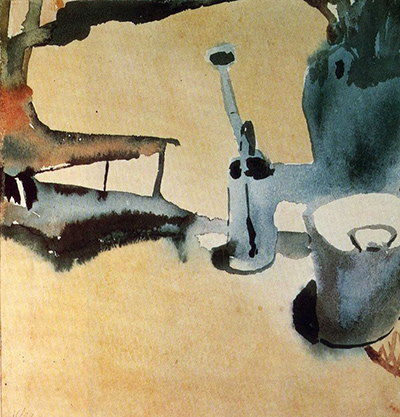Flower Stand with Watering Can and Bucket (1910) serves as a milestone on Klee’s journey to obtaining artistic expertise.
Superficially, it is the gentle image of a set of gardening implements alongside a sun lounger. However, Klee has used a bright yellow background to cast the foreground objects into shadowy dark blues and deep reds, a technique learned from the nineteenth-century impressionists.
These colours are not naturalistic; the ground is as saturated with yellow as is the background, and the interior of the bucket is an unnatural white.
Expressionism seeks to depict unseen emotion as much as it does the visible world, and Klee has succeeded in expressing the feeling of a sunny afternoon in the garden as much as painting a scene from it.
The edges of the blue watercolour blending into the bright yellow heighten this expression but may also represent Klee’s loss of control over his media. By the time he painted Park Near Lucerne, he was employing collage to achieve crisp edges and definable blocks of colour.
Paul Klee (1879-40) was born in Switzerland. During his study at the Academy of Fine Arts in Munich, Klee believed that he was a sketch artist who would never master the handling of colour.
Eventually, he graduated and met artists from Der Blaue Reiter or the Blue Rider group, including Wassily Kandinksy and Franz Marc. This artistic group rejected nineteenth-century, literal interpretations in favour of a more abstract and spiritual expression of the environment, placing the group within the wider artistic movement of Expressionism.
That Klee did succeed in handling colour is evident in his later paintings. In A Young Lady’s Adventure (1922), stylised imagery of birds, fishes and small animals surround the figure of a smiling young girl.
The scene is a blend of greys, greens and lemons, the harmonious handling of which could be achieved only by a master colourist. Touches of bright red add tension to the image and indicate that a drama is about to unfold.
Klee’s Park Near Lucerne (1932) is even more stylised. Auras of bright colour surround the figures of men, trees and boats that have been reduced to dark lines and curves. Again, Klee demonstrates his colour expertise in placing red against blue, and green against yellow.




